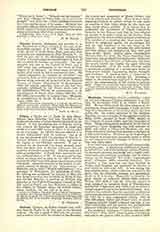

Cicognara, LEOPOLDO, COUNT, politician, writer on art, and collector of Italian antiquities, b. at Ferrara, November 26, 1767; d. at Venice, March 5, 1834. He was thirty years old when pressure of circumstances, Bonaparte’s campaigns in Italy, and the hope of a risorgimento in his country drove him into public life. An ardent supporter of the Cisalpine Republic, he was a member of the legislative body at Milan (1798), minister to Turin (1799), deputy to the Congress of Lyons (1801), and also Councillor of State. Being subsequently implicated in the Ceroni conspiracy, Count Cicognara was held prisoner at Milan and exiled to Como and Florence, but was finally restored to his functions and sent to Bologna on a diplomatic mission. However, at the beginning of the Empire he retired from the public career in which he had experienced such changes of fortune, being then only thirty-eight.
From that time on he devoted himself unreservedly to the fine arts. A friend from childhood of Canova, a pupil of Corvi and of the landscape-painter Hackert, he combined extensive knowledge and a highly cultivated taste with practical knowledge, and his dissertations on the beautiful “Del Bello, ragionamenti sette”, (Florence, 1808) attracted attention. The Academy of Fine Arts had just been founded in Venice, and Cicognara was appointed its director, a post which he held until 1827. It was during this long administration, which must ever redound to his glory, that the admirable museum was established, about as it is today. Meanwhile he finished his great history of sculpture (Storia della scultura, Venice, 1813-1818, 3 vols. fol. with 131 plates), a work designed to complete those of Winckelmanr and Seroux d’Agincourt, and which won its author a foreign member’s seat in the Institute of France. It is, however, less valuable than his masterful publication on the manufactures and monuments of Venice (2 vols. fol. 1815-20; a new, augmented edition, 1833-40 with 250 plates, Italian and French text), in which Cicognara showed himself a learned historian of the city’s antiquities, and the worthy and indispensable precursor of Ruskin and his “Stones of Venice“.
The analytical catalogue (“Catalogo ragionato dei libri d’arte”, Pisa, 1821), which he made of his library and sold to the pope in 1824, is still a model of bibliography. Towards the close of his life Cicognara became an enthusiast for niello, and wrote a memoir which has since remained a classic (Memorie spettanti alla storia della calcografia, Prato, 1831, with atlas).
The appearance of this treatise created such a demand for this kind of enamel that many spurious pieces were manufactured and sold as part of the Count’s collection, and Cicognara himself was, in consequence, accused of counterfeiting. But modern critics have exonerated him. His last enthusiasm had for its object rare engravings, with which his curio-hunting had made him singularly familiar; he collected over 3000 belonging to the fifteenth and sixteenth centuries, and after his death they were catalogued by his nephew, Count Nanetti, and Ch. Albrizzi, under the title, “The First Century of Calcography” (Venice, 1837).
LOUIS GILLET

